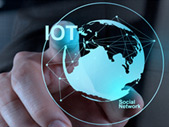Internet of Things - An introduction and India adoption By Yash Menghani

Internet of Things (IoT) describes a system where items in the physical world, and sensors within or attached to these items, are connected to the Internet via wireless and wired Internet connections. These sensors can use various types of local area connections such as RFID, NFC, Wi-Fi, Bluetooth, and Zigbee. Sensors can also have wide area connectivity such as GSM, GPRS, 3G, and LTE.
Though IoT is the most discussed technology but it is not a new concept. With improved mobile and broadband connectivity over 50 billion devices will be connected by 2020. IoT will connect both motionless and living things, use sensors for data collection and change the kinds of things that will communicate over an IP network. Currently IoT is considered to communicate, control & automate and save costs but the future of IoT is much wider and extensive. The IoT market offers immense revenue generation opportunities in the following areas:
- Business intelligence and analytics for decision support
- Security level management and performance management
- Professional services including consulting, integration and software development
- Connectivity and communication services, associated hardware, devices and components
The wide adoption of the IoT may need customised technology solutions that are suitable for the country. The low-power wide area network (LPWAN) technologies like LoRa have an excellent fit in the Indian context of smart cities and smart agriculture. Sigfox, NB-IoT, etc, are also gaining importance for the same reasons.
IoT provides unique opportunity that enables businesses to turn data into insights. Analytics and cloud computing are some of the market forces driving the growth of IoT. The adoption of IoT will improve mobility, decision making, smarter lifestyle and analysis of critical data from connected sensors to take pro-active decisions for better efficiencies and savings costs.
INDIA IoT
India is on a rapid growth path on IoT technology with market size of $1.3 billion in 2016 expected to grow exponentially to $15 billion by 2020 I.e. 5% of the global market. 2.7 billion units will be connected by 2020 as compared to 200 million units currently. Other than smart phones and computers, there are about 60 million devices connected with internet. IoT solution deployment for digital utilities or smart cities and in the manufacturing, transport and logistics and automotive industries would drive the demand for industrial IoT applications. The huge demand and adoption is going to arrive from home automation that will bring the ROI for IoT solution developers. Investors have been taking active interest in IoT startups with over $60 million invested in the last 2 years.
Healthcare and manufacturing are the leading industrial verticals demanding for IoT while transport and logistics are the next generation verticals gaining adoption. Health, Fitness and home automation will be driven by personal interest.
Though initial focus would be on providing SIMs for IoT devices and solutions, which in 2017 is expected to take off, leading to over a billion additional SIM sales in the next three years. However, some of the leading operators, as part of the long-term play, would spin off new IoT entities that would provide them with the flexibility and reason to focus on being an end-to end IoT solution provider rather than just a connectivity provider.
The Indian government has launched various projects (such as the ‘100 smart cities’ project) and is encouraging for organisations to implement IoT. The smart cities project is expected to play a vital role in the overall growth of the market. The World Bank and the Asian Development Bank (ADB) are expected to provide loans of US$ 500 million and US$ 1 billion, respectively, to India for this project. Amongst all the IoT applications, industrial applications account for the maximum revenue share in the Indian market owing to their growing usage in energy management, smart buildings, manufacturing, and the environment. (source: Convergence Plus Bureau)
« Back
|